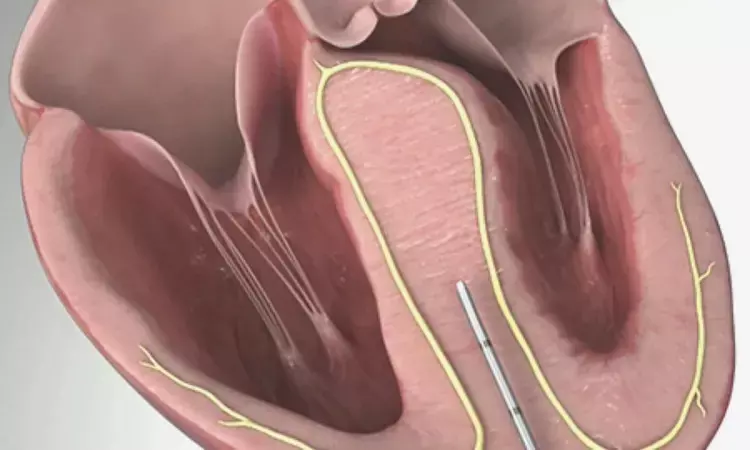- Home
- Medical news & Guidelines
- Anesthesiology
- Cardiology and CTVS
- Critical Care
- Dentistry
- Dermatology
- Diabetes and Endocrinology
- ENT
- Gastroenterology
- Medicine
- Nephrology
- Neurology
- Obstretics-Gynaecology
- Oncology
- Ophthalmology
- Orthopaedics
- Pediatrics-Neonatology
- Psychiatry
- Pulmonology
- Radiology
- Surgery
- Urology
- Laboratory Medicine
- Diet
- Nursing
- Paramedical
- Physiotherapy
- Health news
- Fact Check
- Bone Health Fact Check
- Brain Health Fact Check
- Cancer Related Fact Check
- Child Care Fact Check
- Dental and oral health fact check
- Diabetes and metabolic health fact check
- Diet and Nutrition Fact Check
- Eye and ENT Care Fact Check
- Fitness fact check
- Gut health fact check
- Heart health fact check
- Kidney health fact check
- Medical education fact check
- Men's health fact check
- Respiratory fact check
- Skin and hair care fact check
- Vaccine and Immunization fact check
- Women's health fact check
- AYUSH
- State News
- Andaman and Nicobar Islands
- Andhra Pradesh
- Arunachal Pradesh
- Assam
- Bihar
- Chandigarh
- Chattisgarh
- Dadra and Nagar Haveli
- Daman and Diu
- Delhi
- Goa
- Gujarat
- Haryana
- Himachal Pradesh
- Jammu & Kashmir
- Jharkhand
- Karnataka
- Kerala
- Ladakh
- Lakshadweep
- Madhya Pradesh
- Maharashtra
- Manipur
- Meghalaya
- Mizoram
- Nagaland
- Odisha
- Puducherry
- Punjab
- Rajasthan
- Sikkim
- Tamil Nadu
- Telangana
- Tripura
- Uttar Pradesh
- Uttrakhand
- West Bengal
- Medical Education
- Industry
PIMSRA promising alternative to surgical intervention in patients with drug-refractory HOCM: JAMA

China: Percutaneous intramyocardial septal radiofrequency ablation (PIMSRA) may be an alternative to surgical intervention in patients with drug-refractory hypertrophic obstructive cardiomyopathy (HOCM), says a recent study. The study was published in the Journal of the American Medical Association - Cardiology on March 30, 2022.
"In a large patient cohort with drug-refractory HOCM, PIMSRA was shown to be an effective procedure for relief of left ventricular outflow tract obstruction and symptoms with acceptable complication rates," Mengyao Zhou, Xijing Hospital, Fourth Military Medical University, Xi'an, Shaanxi, China, and colleagues wrote in their study.
Patients with HOCM and drug-refractory symptoms and outflow gradients do not have many options for nonsurgical treatment. Previously, researchers reported the feasibility of PIMSRA; however not much is known about procedural and medium-term outcomes. Considering, authors aimed to describe the safety and medium-term outcomes of PIMSRA in a large patient cohort with drug-refractory HOCM.
The single-arm, open-label study of PIMSRA in patients with drug-refractory HOCM included patients presenting to the Xijing Hospital in Xi'an, China, between October 2016 to June 2020 with hypertrophic cardiomyopathy. Of 1314 patients presenting with HOCM, 244 fulfilled inclusion criteria of severe resting/provoked outflow gradients of 50 mm Hg or higher, and symptoms of New York Heart Association functional class of II or higher refractory to maximum tolerated medications. Following discussion among the heart team, 40 patients underwent surgical or alcohol septal reduction therapy, and 4 required treatment of significant coronary artery disease.
30-day major adverse clinical events: emergency surgery, death, procedure-related stroke, severe effusion requiring intervention, stroke, and bleeding. 30-day technical success and 90-day improvement in outflow obstruction were the secondary outcomes.
The mean age of 200 patients was 46.9 years, and 125 (62.5%) were men.
Based on the study, the researchers found the following:
- Resting or provoked left ventricular outflow tract gradients were 50 mm Hg or higher. The median (IQR) follow-up for all patients was 19 months.
- Thirty-day major adverse clinical events rate was 10.5% (n = 21): there were 2 in-hospital/30-day deaths (1.0%), 7 patients (3.5%) with pericardial effusion requiring mini-thoracotomy, 12 patients (6%) with pericardial effusion requiring pericardiocentesis, and no bleeding or strokes.
- Other periprocedural complications included permanent right bundle branch block in 5 patients (2.5%), resuscitated ventricular fibrillation in 2 (1.0%), and septal branch aneurysm in 2 (1.0%). There were no permanent pacemaker implantations.
- At follow-up, the maximum septal thickness was reduced from a mean of 24.0 mm to 17.3 mm, and the left ventricular outflow tract gradient was decreased from a mean of 79.0 mm Hg to 14.0 mm Hg. Overall, 190 patients (96%) with HOCM were in New York Heart Association functional class I or II at the last follow-up.
"PIMSRA in HOCM patients may be a safe and effective procedure for the relief of LVOT obstruction and symptoms at midterm follow-up," wrote the authors. "These results are encouraging and support the design of a randomized clinical trial against well-established septal reduction therapies."
Reference:
Zhou M, Ta S, Hahn RT, et al. Percutaneous Intramyocardial Septal Radiofrequency Ablation in Patients With Drug-Refractory Hypertrophic Obstructive Cardiomyopathy. JAMA Cardiol. Published online March 30, 2022. doi:10.1001/jamacardio.2022.0259
KEYWORDS: JAMA, percutaneous intramyocardial septal radiofrequency ablation, PIMSRA, hypertrophic obstructive cardiomyopathy, drug refractory, Mengyao Zhou, cardiovascular disease, coronary artery disease


